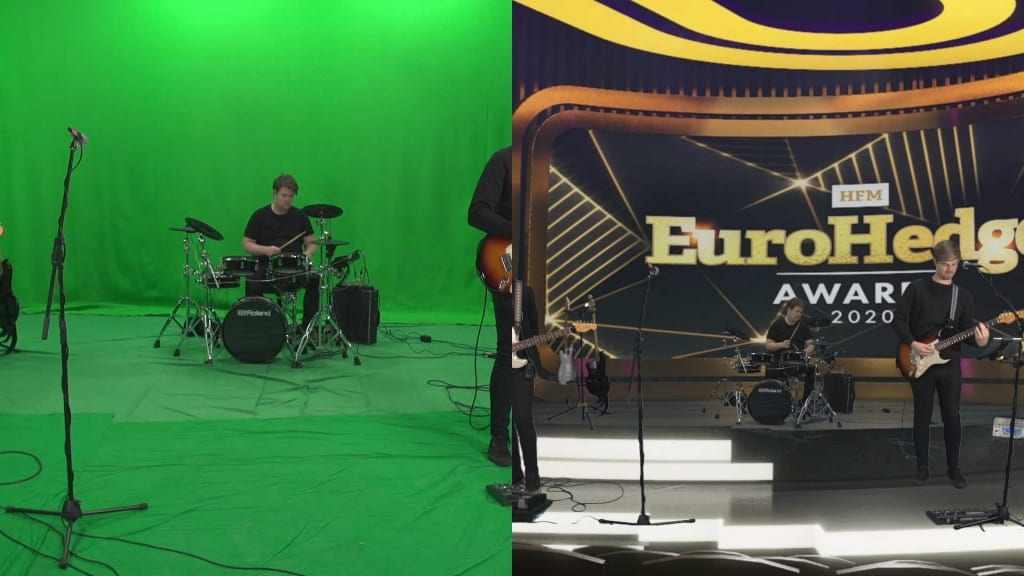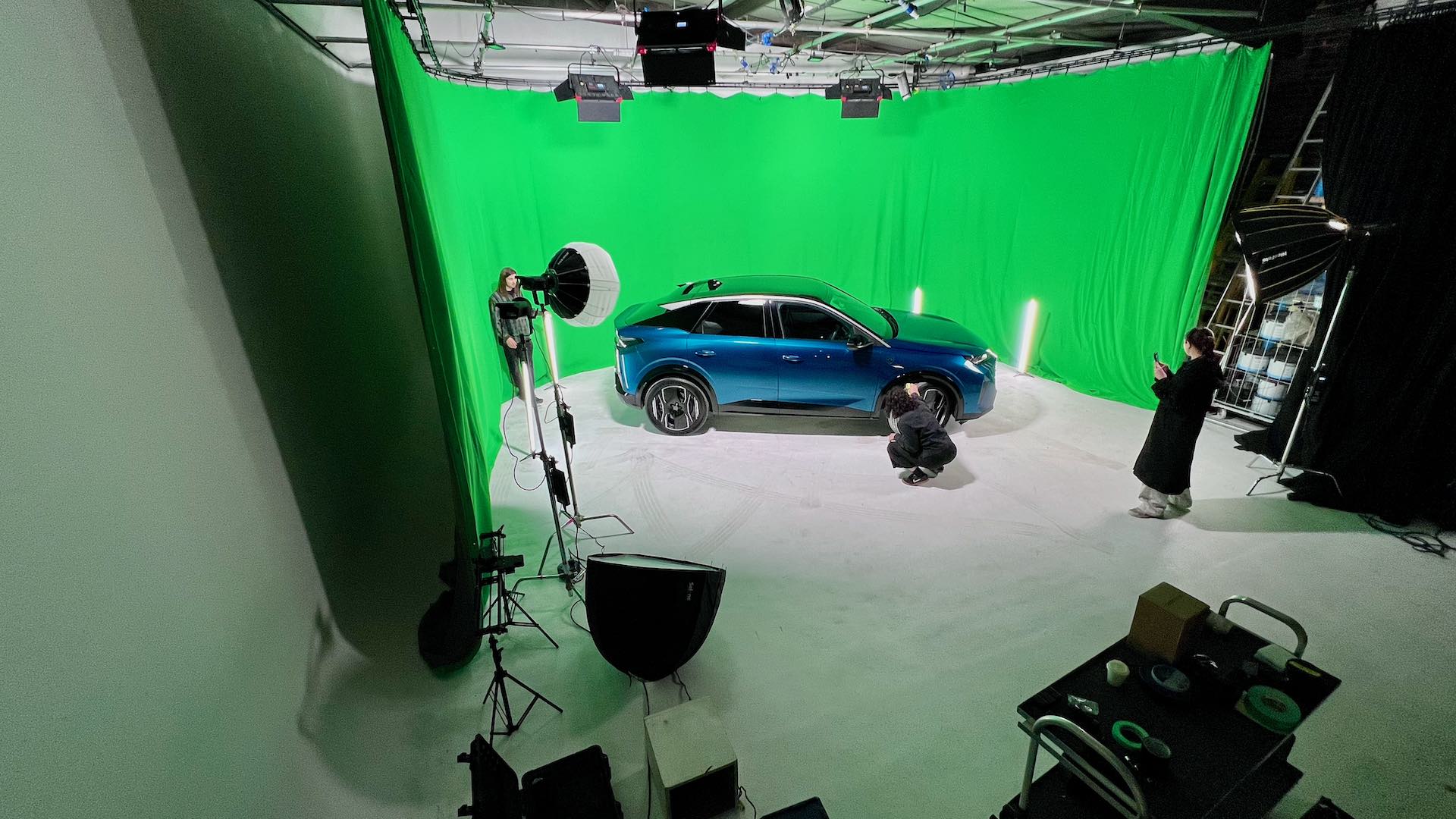What is a Green Screen Studio

Table of Contents
ToggleIn the evolving world of digital media and content creation, green screen technology has become a cornerstone of video production. The ability to transport viewers into virtually any environment—whether a bustling cityscape or an alien planet—makes the green screen studio an indispensable tool for professionals and amateurs alike. But what exactly is a green screen studio, and why is it so crucial in today’s creative processes?
Understanding Green Screen Technology
The Basics of Green Screen
At its core, a green screen studio involves the use of a solid, vibrant green backdrop against which video or images are shot. This green backdrop is later replaced with a different background using a post-production technique known as chroma keying. Chroma keying is the process of isolating a specific colour in a digital image and making it transparent, allowing another image or video to show through.

The colour green is predominantly used because it differs significantly from human skin tones, reducing the likelihood of colour spill—where part of the subject unintentionally blends into the background. Blue screens are also used but less frequently, especially when the scene requires a colour that could conflict with blue elements.
History and Evolution of Green Screen
Green screen technology has its roots in the early days of film. Initially, blue screens were the norm, but as technology advanced and video cameras became more sensitive to light, green screens became the standard due to their better luminance and lower noise levels. The evolution from blue to green screens marked a significant leap in video production quality, enabling filmmakers to create more seamless and visually stunning effects.
Today, green screen technology is not just limited to Hollywood. It has permeated various industries, from broadcasting to social media content creation, due to its versatility and effectiveness.

Components of a Green Screen Studio
The Green Screen Backdrop
The most critical component of a green screen studio is the backdrop itself. Typically, this is a large, seamless fabric or painted wall that is evenly lit to avoid shadows, which can interfere with the chroma keying process. Professional studios often use high-quality materials that are wrinkle-resistant and non-reflective, ensuring the cleanest key possible.
Lighting
Proper lighting is crucial in a green screen studio. Uneven lighting can cause shadows or hot spots on the green screen, making it difficult to key out the background cleanly. Three-point lighting is a common setup used in green screen studios, consisting of:
- Key Light: The primary light that illuminates the subject.
- Fill Light: Used to reduce the shadows created by the key light.
- Back Light: Separates the subject from the background, giving a sense of depth.
Additionally, background lights are used to ensure that the green screen itself is evenly lit, creating a uniform colour for easier post-production.

Camera Equipment
High-quality cameras are essential for capturing the finest details in a green screen studio. The better the camera, the more precise the chroma keying process will be. Cameras with higher resolution and dynamic range can better differentiate the green screen from the subject, reducing the need for extensive post-production correction.
Post-Production Software
The magic of a green screen studio truly comes to life in post-production. Software like Adobe After Effects, Final Cut Pro, and DaVinci Resolve are popular choices among professionals for chroma keying. These tools allow editors to replace the green screen with virtually any background, adjust color spill, and fine-tune the final composition.
Applications of Green Screen Studios
Film and Television

In the film and television industry, green screen studio hire like Cineview Studios are indispensable. They allow directors to shoot scenes in controlled environments and later place the actors in settings that would be impossible or too costly to film in real life. This technology is particularly prevalent in science fiction and fantasy genres, where entire worlds are created in post-production.
Broadcasting
News and weather channels frequently use green screens to display graphics behind the anchors. For instance, weather reporters often stand in front of a green screen that is later replaced with weather maps and other relevant graphics.
Content Creation and Social Media

With the rise of platforms like YouTube and TikTok, green screen studios have become more accessible to everyday content creators. Whether it’s a gamer wanting to overlay themselves on their gameplay or a social media influencer looking to transport their audience to exotic locations, green screen technology has democratised content creation.
Virtual Events and Webinars
In the era of remote work and virtual events, green screens have taken on a new role. Presenters can use green screens to create professional-looking backgrounds during webinars, online classes, and virtual meetings, making their presentations more engaging and visually appealing.
Setting Up Your Green Screen Studio
Choosing the Right Space
The first step in setting up a green screen studio is selecting an appropriate space. The studio hire facilities should be large enough to accommodate the backdrop, studio lighting equipment, and allow for adequate distance between the subject and the green screen to prevent shadows. High ceilings and good ventilation are also desirable to ensure a comfortable working environment.
Assembling the Green Screen

Depending on your budget and needs, your green screen could be a simple fabric backdrop or a more permanent painted wall. It’s crucial to ensure that the green screen is wrinkle-free and taut to avoid any shadows or irregularities that could complicate the keying process.
Lighting Your Studio

Proper lighting setup is key to achieving a professional-looking green screen effect. It’s essential to invest in good quality lights and take the time to adjust them correctly. The goal is to have even lighting across the entire green screen with no shadows or hot spots.
Fine-Tuning Camera Settings
Your camera settings can significantly impact the quality of your green screen footage. Using a high shutter speed can help prevent motion blur, which can complicate the keying process. Additionally, adjusting the ISO to avoid graininess and using manual focus to keep the subject sharp are important considerations.
Post-Production Tips
After shooting, the post-production process is where your green screen studio truly shines. Using advanced software, you can replace the green background with any scene or graphic you desire. It’s important to take your time during this process, as even small adjustments can make a significant difference in the final output.
Conclusion
A green screen studio is a powerful tool that unlocks unlimited creative potential. From professional filmmakers to hobbyist content creators, this technology enables anyone to create stunning visual effects that captivate audiences. By understanding the components and applications of a green screen studio, you can harness its full potential and bring your creative visions to life.
Green Screen Studio FAQ
What is a green screen studio?
A green screen studio is a space equipped with a solid green backdrop, professional lighting, and camera equipment, used for filming or photographing subjects. The green backdrop is replaced with a different background in post-production through a technique called chroma keying.
Why is green the preferred colour for green screens?
Green is used because it is not commonly found in human skin tones or clothing, which helps in cleanly isolating the background for chroma keying. It also has better luminance and is easier for digital cameras to capture, resulting in less noise and a clearer image.
Can I use a blue screen instead of a green screen?
Yes, blue screens are also used, especially when the subject contains green elements. However, green screens are generally preferred due to their higher luminance and better performance in most lighting conditions.
What equipment do I need to set up a green screen studio?
To set up a green screen studio, you’ll need the following:
- A large, wrinkle-free green backdrop.
- Proper lighting equipment (key lights, fill lights, and backlights).
- A high-quality camera.
- Post-production software for chroma keying, such as Adobe After Effects or Final Cut Pro.
How do I avoid shadows on the green screen?
To avoid shadows, ensure that the green screen is evenly lit. Use separate lights to illuminate the backdrop and the subject, and position the subject at a sufficient distance from the screen to prevent shadows from falling on it.
Can I set up a green screen studio at home?
Yes, many content creators set up green screen studios at home. You’ll need a space with enough room to accommodate the backdrop, lighting, and camera. Make sure the room has controllable lighting and a flat, even surface for the green screen.
What software can I use for chroma keying?
Popular software for chroma keying includes:
- Adobe After Effects
- Final Cut Pro
- DaVinci Resolve
- iMovie (for simpler projects)
How do I choose the right lighting for my green screen studio?
Choose lighting that provides even coverage across the green screen. LED lights are popular due to their adjustable brightness and color temperature. A three-point lighting setup (key, fill, and backlight) is recommended to achieve a professional look.
What are common mistakes to avoid when using a green screen?
Common mistakes include:
- Uneven lighting, leading to shadows or hot spots.
- Wrinkled or reflective green screens, causing difficulties in keying out the background.
- Subject wearing green, which can cause parts of them to disappear during the chroma keying process.
- Insufficient distance between the subject and the green screen, leading to shadows and color spill.
How far should the subject stand from the green screen?
The subject should stand at least 6 to 10 feet away from the green screen to minimize shadows and prevent color spill, where green light reflects onto the subject, complicating the keying process.
Can I use any green fabric for a green screen?
While you can use various green fabrics, it’s best to choose a material that is non-reflective and wrinkle-resistant. Professional green screens are made of materials that are optimized for even lighting and minimal reflection.
Is it possible to use a green screen outdoors?
Yes, a green screen can be used outdoors, but controlling the lighting is more challenging. Outdoor setups may require additional equipment, such as diffusers or reflectors, to manage natural light and avoid shadows.
What types of projects benefit most from using a green screen?
Green screens are beneficial for a wide range of projects, including:
- Film and television production
- YouTube videos and social media content
- Virtual events and webinars
- Educational videos
- Marketing and promotional videos
How much does it cost to set up a green screen studio?
The cost can vary greatly depending on the quality and size of the equipment. A basic home setup might cost a few hundred dollars, while professional green screen studios can require thousands of dollars for high-end lighting, cameras, and post-production software.
Can I achieve professional results with a DIY green screen studio?
Yes, with the right techniques and attention to detail, a DIY green screen studio can produce professional-quality results. Focus on proper lighting, high-quality camera settings, and meticulous post-production work.
5 thoughts on “What is a Green Screen Studio”